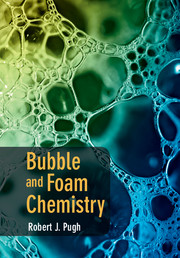Book contents
- Frontmatter
- Contents
- Preface
- Acknowledgments
- List of symbols
- 1 Basic principles and concepts
- 2 The nature and properties of foaming surfactants
- 3 Soap bubbles and thin films
- 4 Processes in foaming
- 5 Generation of bubbles and foams
- 6 Coalescence of bubbles in surfactant solutions
- 7 The stability/instability of bubbles and foams
- 8 Particle-stabilized foams
- 9 Foaming in non-aqueous liquids
- 10 Antifoaming and defoaming
- 11 Bubble size measurements and foam test methods
- 12 Bubble and foam chemistry - new areas of foam research
- Index
- References
12 - Bubble and foam chemistry - new areas of foam research
Published online by Cambridge University Press: 05 September 2016
- Frontmatter
- Contents
- Preface
- Acknowledgments
- List of symbols
- 1 Basic principles and concepts
- 2 The nature and properties of foaming surfactants
- 3 Soap bubbles and thin films
- 4 Processes in foaming
- 5 Generation of bubbles and foams
- 6 Coalescence of bubbles in surfactant solutions
- 7 The stability/instability of bubbles and foams
- 8 Particle-stabilized foams
- 9 Foaming in non-aqueous liquids
- 10 Antifoaming and defoaming
- 11 Bubble size measurements and foam test methods
- 12 Bubble and foam chemistry - new areas of foam research
- Index
- References
Summary
You never change things by fighting the existing reality. To change something, build a new model that makes the existing model obsolete.
R. Buckminster Fuller, www.azquotes.comAntibubbles
Antibubbles, which have sometimes been referred to as negative bubbles or inverted bubbles, have been known for at least 70 years. They were first reported in 1931/2 by Katalinic (1) and Hughes and Hughes (2) and originally considered as a scientific curiosity. Essentially, the structure of an antibubble consists of a thin shell or core of air which is separated by liquids, with the surfactant adsorbed at the inner and outer interfaces of the shell. The polar heads of the chemical surfactant are immersed in the aqueous medium, while the nonpolar tails face and extend into the gas. This is the exact opposite situation to a bubble where the thin shell of liquid separates the air inside and outside the bubble. The shell of air on the antibubble is about 10 nm thick and can generate interference colors. Antibubbles are formed at surfactant concentrations below and above the CMC, and several different types of surfactants have been used in their preparation. Dishwashing detergents were often used in the generation process, but more recently they have been prepared using different types of conventional long-chain nonionic, anion and protein (beer) surfactants (3). It is also interesting to note that antibubbles can be generated and stabilized by partially hydrophobic particles (4). Most studies in antibubbles have been mainly concerned with generation rather than stability. In Fig. 12.1, the structure of a common bubble is compared with chemically stabilized antibubbles and particle-stabilized antibubbles.
In recent years, several interesting applications have been put forward. For example, it has been suggested that they can be used as antifoams or new types of lubricants analogous to ball bearings or filtration systems in which the web of passageways would be permeable to gas molecules (5). Since antibubbles provide twice the surface area of ordinary bubbles of the same size, another potential application could be the control of chemical reactions. It has also been shown that it is possible to replace air in the antibubble inner shell with other liquids or dyes, suggesting that they could be used as a drug delivery system.
- Type
- Chapter
- Information
- Bubble and Foam Chemistry , pp. 405 - 419Publisher: Cambridge University PressPrint publication year: 2016



